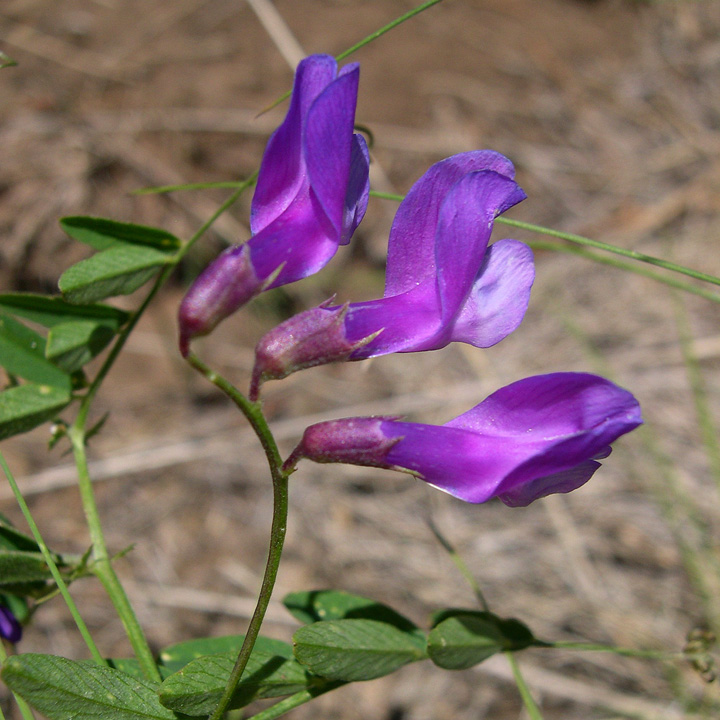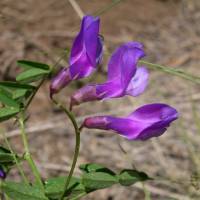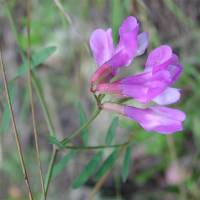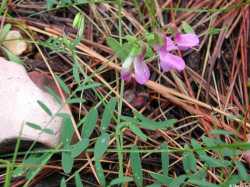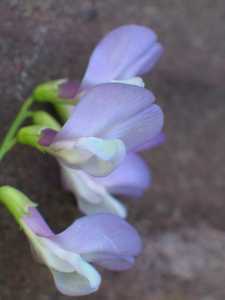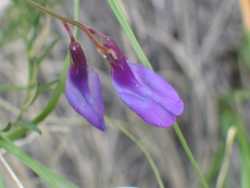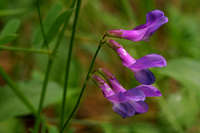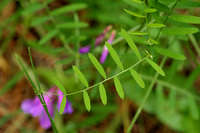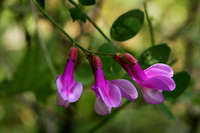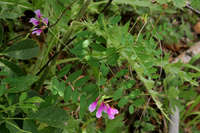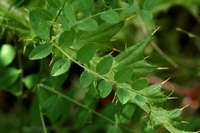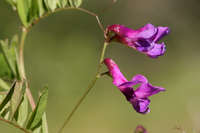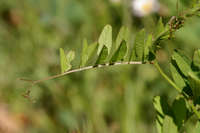Perennial, Herbs, Plants with rhizomes or suckers, Nodules present, Stems erect or ascending, Stems or branches arching, spreading or decumbent, Stems prostrate, trailing, or mat forming, Stems less than 1 m tall, Climbing by tendrils, Stems solid, Stems or young twigs glabrous or sparsely glabrate, Stems or young twigs sparsely to densely hairy, Leaves alternate, Leaves petiolate, Stipules conspicuous, Stipules green, triangulate to lanceolate or foliaceous, Stipules persistent, Stipules free, Stipules cordate, lobed, or sagittate, Stipules toothed or laciniate, Leaves compound, Leaves even pinnate, Leaf or leaflet margins entire, Leaflets opposite, Leaflets alternate or subopposite, Leaflets 5-9, Leaflets 10-many, Leaves glabrous or nearly so, Leaves hairy on one or both surfaces, Flowers in axillary clusters or few-floweredracemes, 2-6 flowers, I nflorescences racemes, Inflorescence axillary, Bracts very small, absent or caducous, Flowers zygomorphic, Calyx 5-lobed, Calyx gibbous, inflated, or spurred, Calyx glabrous, Petals separate, Corolla papilionaceous, Petals clawed, Petals blue, lavander to purple, or violet, Banner petal ovoid or obovate, Wing petals narrow, oblanceolate to oblong, Wing petals auriculate, Wing tips obtuse or rounded, Keel tips obtuse or rounded, not beaked, Stamens 9-10, Stamens diadelphous, 9 united, 1 free, Filaments glabrous, Style terete, Style sharply bent, Style hairy, Style hairy on one side only, Style with distal tuft of hairs, Fruit a legume, Fruit stipitate, Fruit unilocular, Fruit freely dehiscent, Fruit oblong or ellipsoidal, Fruit exserted from calyx, Valves twisting or coiling after dehiscence, Fruit glabrous or glabrate, Fruit 3-10 seeded, Seeds ovoid to rounded in outline, Seed surface smooth, Seeds olive, brown, or black, Seed surface mottled or patchy.
Duration: Perennial
Nativity: Native
Lifeform: Vine
General: Small perennial herbaceous vining or trailing herb, plants glabrous to densely pubescent, up to 1 m long.
Leaves: Pinnate, with mucronate or cuspidate tips, pedicels ending in tendrils, leaves 8-18 foliolate, the leaflets usually ovate to elliptic, obtuse at the apex, 15-35 mm long, 6-14 mm wide.
Flowers: Peduncled racemes with 2 to many flowers, corollas purple, 15-25 mm long, calyx teeth much shorter than to tube, stamens united below, style with a sub-apical tuft of hairs.
Fruits: Narrow, flat, 2-valved pods, dehiscent, 25-35 mm long.
Ecology: Found in pine forests from 5,000-10,000 ft (1524-3048 m); flowering May-September.
Notes: This species is highly morphologically variable, and is somewhat common, look to the large, showy inflorescences to help identify this species. According to Kearney and Peebles, some common morphotypes are the typical phase with thin, broad leaflets to 10 mm wide and rounded or acute tips, the var. linearis, which has thick and prominently veined leaflets, and the var. truncata, which truncated leaflets which are emarginate and and denticulate at the apices. All are noted to intergrade.
Ethnobotany: The leaves were used to soothe spider bites, and the roots were used by women as a love medicine. An infusion of the plant was used as an eyewash, and in baths to ease sore muscles. The plants were used as greens, and seeds and peas were used as food. The plants were burnt and the smoke given to horses to increase endurance, and the plants were used as fodder. The roots were used for tying, and a small bunch was kept in the pocket for luck during gambling.
Etymology: Vicia comes from the classical Latin name for this genus, while americana means of or from America.
Synonyms: Many, see Tropicos
Editor: LCrumbacher, 2011
Trailing or climbing perennial to 1 m; stipules all or mostly sharply serrate; lfls usually 4-8 pairs, 1.5-3 cm; racemes shorter than the subtending lvs, loose, with 2-9 blue-purple fls 15-27 mm; cal-tube very oblique, 3.5-5.5 mm, the upper lobes to 1 mm, the lower 1.2-3 mm; fr 2.5-3.5 cm; 2n=14, 28. Moist woods; c. N.Y. and s. Ont., s. in the mts. to w. Va., w. to Minn. and Mo., and widely distributed in w. N. Amer. May-July. Most of our plants are the widespread var. americana, with elliptic or oblong lfls 5-12 mm wide, the mucronate summit otherwise obtuse to broadly rounded, the numerous lateral veins leaving the midrib at an angle of about 45 degrees and branching and anastomosing before reaching the margin. The var. minor Hook. (var. angustifolia, V. sparsifolia) grows chiefly on the Great Plains and westward, but sometimes occurs within our western border; it has thick, narrow, densely puberulent lfls with prominent, essentially unbranched lateral veins that leave the midrib at a very narrow angle. Occasional plants in our range with truncate or emarginate lfls sharply toothed toward the summit, otherwise like var. americana, resemble or actually represent the otherwise chiefly cordilleran var. truncata
(Nutt.) Brewer. (V. truncata)
Gleason, Henry A. & Cronquist, Arthur J. 1991. Manual of vascular plants of northeastern United States and adjacent Canada. lxxv + 910 pp.
©The New York Botanical Garden. All rights reserved. Used by permission.


